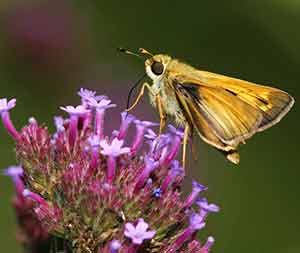Phlox: A Butterfly and Moth Magnet
by Claire Hagen Dole
North American Native
 Imagine strolling through a cutting garden on a balmy summer day,
basket and shears in hand. As you gather a bouquet of colorful flowers,
you notice a tiger swallowtail sipping nectar from a fat cluster of pink
blossoms. Soon you're inhaling the plants sweet perfume, and you are as
captivated by garden phlox (Phlox paniculata) as the butterflies,
bumblebees and moths that pollinate it.
Imagine strolling through a cutting garden on a balmy summer day,
basket and shears in hand. As you gather a bouquet of colorful flowers,
you notice a tiger swallowtail sipping nectar from a fat cluster of pink
blossoms. Soon you're inhaling the plants sweet perfume, and you are as
captivated by garden phlox (Phlox paniculata) as the butterflies,
bumblebees and moths that pollinate it.
Although garden phlox (also called summer phlox) is the most common offering at nurseries, there are more than sixty species of phlox. All but one are North American natives (Phlox sibirica occurs in Siberia). Phlox can be tall, with thick, glossy leaves, or it can spread across the ground with needle-like leaves. It can be a midsummer sun-lover or bloom in shady woods in April. All forms have five petals, often with a colored eye, on a tubular base.
The genus name, Phlox, is derived from the Greek word for flame. Phlox is sometimes called flame flower because of its intense, hot colors.
Only one species (Phlox drummondii) is an annual. The bright red flowers of this Texas native attracted the attention of Thomas Drummond, a British naturalist, in the 1820s. He sent seeds to Europe, where the plant was bred into a variety of colors. It became a popular bedding plant, returning to charm Americans four decades later.
Garden phlox, introduced to England in 1730, didn't recross the Atlantic until Victorian times. The wildflower of muddy-purple hue had been transformed into a sophisticated garden flower, available in shades of red, purple, pink or white. Today's choices include a multitude of cultivars, bred for disease resistance or color, such as 'Starfire' (cherry-red) and 'Prime Minister' (white with red eye).
Span the Seasons
By choosing different phlox species, you can fill your garden with color from spring through late summer. Start with woodland phlox (P. divaricata), a Midwest native with periwinkle-blue flowers and glossy, lance-like leaves. A valuable early-season nectar source, it forms slowly-spreading clumps that make a good ground cover (to 18 high). Plant woodland phlox under flowering shrubs, in humus-rich soil. Very fragrant cultivars include the ice-blue 'Clouds of Perfume'.
'Chattahoochee', a hybrid derived from woodland phlox and prairie phlox (P. pilosa), has fragrant lavender-blue flowers with a maroon eye. It forms a nice ground cover in a moderately sunny location, but is less happy when confined in a pot. 'Chattahoochee' blooms in late spring (to 1' high); cut back after flowering for a neat appearance.
Creeping phlox (P. stolonifera), a ground cover (to 8") that spreads by runners, is loaded with pink-to-purple blossoms in spring. After bloom ends, its hairy, rounded leaves stay attractive through even hot, steamy summers. Native to the deciduous woods of the East, creeping phlox likes moist, humus-rich soil in part shade. Look for 'Bruce's White', 'Pink Ridge' or 'Sherwood Purple'.
Alpine-garden plants that bloom in spring include moss phlox (P. subulata), a Northeast native, and the Northwest natives Douglas phlox (p. douglasii) and spreading phlox (P. diffusa). Tough and spiky, these creeping phloxes (to 6") tolerate hot, dry conditions. Flower colors include pink, purple, blue and white; they have a faint, sweet scent and are attractive to early pollinators.
Wild Sweet William (P. maculata) blooms in early summer, with mounds of dark-pink blossoms (to 3'). Native to Appalachian states, it grows best in moist, rich soil, in full sun or partial shade. If deadheaded, it may bloom again in autumn. 'Miss Lingard', white with a pale-yellow eye, is sometimes listed as a cultivar of thick-leaved phlox (P. carolina). Often called wedding phlox because it blooms in June, 'Miss Lingard' made its debut almost a century ago.
Annual phlox (P. drummondii) will bloom from midsummer well into fall, if deadheaded. Give it full sun and amended soil. 'Fordhook Finest Mix' (to 18") is a mix of dark pink, lavender, white, pale yellow and bicolors. Dwarf strains (6") include 'Globe' and 'Twinkle'.
Garden phlox (P. paniculata), native to the eastern half of the U.S., likes rich, well-drained soil and full to partial sunlight. Reaching as high as 5', summer phlox puts on a colorful show for several weeks from mid- to late summer. Its sweet perfume lures a variety of butterflies, such as swallowtails, Painted Ladies, Great Spangled Fritillaries, sulphurs and skippers. Deadhead to prevent self-seeding, as volunteers will revert to less attractive colors. Divide the clump every few years and reset the young shoots from the clump's edge into fresh, amended soil. Garden phlox is easy to propagate from cuttings.
Under the Moonlight
Butterflies, bumblebees and an occasional hummingbird may find phlox irresistible, but its charms aren't restricted to these daytime pollinators. Hawkmoths may hover next to its blossoms from late afternoon to dusk. On summer evenings, as the sweet scent of phlox drifts across the garden, night moths may be drawn to the flowers. Although many phlox varieties are attractive to moths, those with pale-colored or white blossoms are true stars after dark.
There are several white-flowering choices for the moonlit garden (unless noted, cultivar is widely available): Phlox maculata 'Miss Lingard' and 'Omega'; P. paniculata 'David', 'Delta Snow' [Niche], 'Fujiyama', 'Prime Minister' and 'World Peace' [Ambergate]; P. divaricata 'Fuller's White'; P. douglasii 'May Snow' [Siskiyou]; P. subulata 'Amazing Grace' and 'Schneewittchen' [both Siskiyou]; P. stolonifera 'Bruce's White'; and P. nivalis 'Snowdrift' [Niche]--a rare white form of the usually-pink trailing phlox that is a Southeast native.
The Mildew Question
Given phlox's appeal to gardeners and visiting insects, how best to keep the dreaded powdery mildew at bay? Your locale, of course, has much to do with success: phlox in my Northwest garden won't be as stressed as a similar plant in the humid South. Phlox varieties that bloom in spring and early summer are less likely to be troubled, since mildew strikes hardest in August and September.
Some gardening practices will help to minimize mildew infestation: plant in full sun; water at ground level instead of using a sprinkler; thin out stems to increase air movement; and remove infected foliage in the fall so mildew spores can't overwinter.
New phlox cultivars, often touted as being mildew-resistant, appear in nursery catalogs each year. Are they superior to the antique varieties they displace? In The Heirloom Garden [Storey, 1992], Jo Ann Gardner states, "We are told that modern Phlox types are vastly improved over older kinds... but if you look around in older gardens, you will find an astonishing range of flowers doing very well, some growing on their own for sixty years or more, all beautiful and disease-resistant."
Rachel Kane, of Perennial Pleasures Nursery, echoes this sentiment. "Some varieties are much less susceptible to mildew, particularly the older ones. By the 1940s there were over 220 named varieties available; most of these have sadly gone missing." Kane emphasizes dividing plants regularly and watering adequately to prevent mildew. She is actively searching for old varieties and welcomes reader input.
Phlox Trials
Twenty phlox selections (half of them cultivars of P. paniculata) were grown at Chicago Botanic Garden in a recent four-year study of mildew resistance. Maintenance practices were kept to a minimum; plants were irrigated as needed, but no fertilizer or fungicides were applied. Plants were evaluated for overall appearance, bloom period, disease and pest resistance, cultural adaptability, and winter hardiness.
Richard G. Hawke, Coordinator of Plant Evaluation Programs, reports some surprising findings from the study. While the popular P. paniculata 'David', always touted as mildew-resistant, received a good rating, it didn't perform as well as 'Katherine', a little-known cultivar [Viette]. And three cultivars of the highly-regarded P. maculata--'Alpha', 'Omega' and 'Rosalinde'--showed poor resistance to mildew.
Highest ratings for mildew resistance went to P. 'Chattahoochee'; P. 'Spring Delight'; P. glaberrima ssp. triflora and 'Don Hackenberry'; P. pilosa and P. pulchra 'Morris Berd'. Highest overall honors were awarded to P. 'Chattahoochee'; P. pulchra 'Morris Berd'; P. paniculata 'Katherine' and P. carolina 'Reine du Jour' (now mysteriously unavailable in nurseries).
The Chicago Botanic Garden is currently testing eight new P. paniculata cultivars from Germany, including such intriguing selections as 'Fliedertraum' and 'Rosa Goliath'. Another trial, initiated in May, will compare 30 P. paniculata cultivars (both old and new). Hawke is especially interested in evaluating the Spring Pearl Series, which is touted as being highly mildew-resistant. All have women's names, such as 'Miss Jill' and 'Miss Karen'.
Article by Claire Hagen Dole, Publisher/editor of Butterfly Gardeners' Quarterly. Summer 2000.



